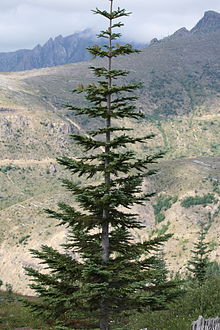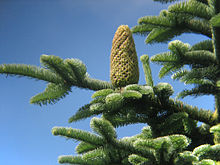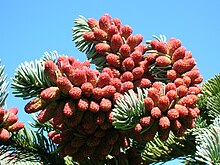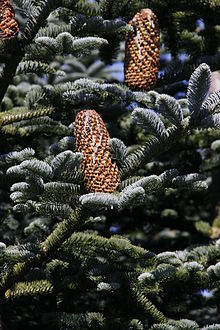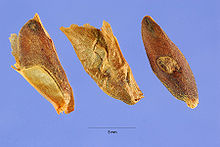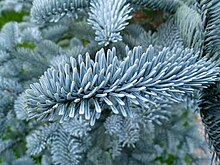Noble fir
| Noble fir | ||||||||||||
|---|---|---|---|---|---|---|---|---|---|---|---|---|

Broad, cylindrical growth of the noble fir ( Abies procera ) and narrow columnar growth of the Nordmann fir ( Abies nordmanniana ) in Benmore |
||||||||||||
| Systematics | ||||||||||||
|
||||||||||||
| Scientific name | ||||||||||||
| Abies procera | ||||||||||||
| Rehd. |
The noble fir ( Abies procera , Syn. : Abies nobilis ), standard language Edeltanne also Pacific noble fir and silver fir called, is a plant from the genus of the fir ( Abies ) in the family of Pinaceae (Pinaceae) of higher layers of the Cascade Mountains in the western United States. As the largest of all firs, it has the smallest area of the Pacific firs in North America and is also the New World fir that needs the most light. After the production of Sitka spruce wood in the spring of 1942 could not meet the demand of the US and British aircraft industries during World War II due to the land lease system, the only tree species that were found in the wood of the noble fir and the western hemlock were New construction in aircraft design was not required. In the summer of 1942 the noble fir gained great economic and military importance as a substitute for the Sitka spruce, which in 1943 led to the maximum use of resources of the noble firs in the mountain forests of the Pacific Northwest.
etymology
The species was discovered on September 7, 1825 by David Douglas on the Columbia River (Columbia gorge) not far from the Grand Rapids in present-day Oregon together with the purple fir ( Abies amabilis ). He first called it Pinus nobilis - noble fir ( in the 19th century, pinus was still a regular generic term for fir). Your taxonomically correct epithet procera comes from the Latin procerus and means "high". For David Douglas, the noble fir was the most impressive tree he had discovered on his expeditions in the western part of today's USA. In 1830 he wrote: “I spent three weeks in a forest made up of this species of tree and day after day I could not stop admiring it; my words are just monotonous expressions of this feeling ”. This special impression of natural noble fir forests is created by their high columnar shafts, two-thirds of which are usually free of knots. As a result, they are also among the best suppliers of construction timber among the softwood trees in the western USA.
The hyphenated spelling is common in German botanical specialist literature. Colloquially, the European white fir ( Abies alba Mill.) Is also known as the “noble fir ” or “silver fir”.
description
Habitus
The noble fir is an evergreen tree that reaches the greatest heights among the firs, with heights of over 80 meters and trunk diameters ( BHD ) of over 2 meters. It has strikingly straight, columnar trunks. The treetop is symmetrically conical. It is not as dense as other types of fir and therefore often appears transparent. Leading instincts often die at the summit; in old age, the side branches tower above the summit shoot, and the so-called “stork's nest crown” forms. The branches are usually at right angles from the trunk, but can also hang in the lower part of the crown. The slender branches are reddish-brown in color and hairy. The top of the branch is usually not recognizable because of the close-fitting needles. The noble fir can live up to 800 years and thus reaches the highest age of all fir species.
Buds and needles
The round buds are very small and have red-brown scales. They are often hidden by the needles. The blue-green shimmering, densely packed needles have a lifespan of up to twelve years. The needles, which are square in cross-section, are 25 to 35 millimeters long and deeply grooved on top. There are ostomy straps on both the top and the bottom . Needles in areas exposed to light are usually blue-green in color and spiral upwards around the branch. Shadow needles are usually dark green in color and parted on the underside of the twig. The needles lie on the branch in the first quarter and curve up.
Flowers, cones and seeds
The noble fir is single-sexed ( monoecious ). It becomes manable at the age of 20 to 30, but full semen production does not begin until the age of 50 to 60. The male cones are dark red in color and sit in groups of up to 30 cones on the underside of the branch. The inconspicuous female cones are yellowish in color with a pale reddish tone and are usually single, but also in pairs, rarely in groups of five on the upper side of previous year's shoots.
The cones have a length of 10 to 24 centimeters and a diameter of 5 to 7 centimeters. This makes them the largest cones of all known types of fir. Cones are set on young trees that are only 2 to 3 meters tall. The ripe cones are pale purple-brown, but appear pale green because they are predominantly covered by the greenish cover scales. The seed scales are about 2.5 inches by 3 inches. The reddish-brown seed has a size of 13 millimeters × 6 millimeters and has a light brown to straw-colored wing that is only slightly longer than the seed. The thousand grain weight is around 30 grams and the germination capacity is 30 to 70%. The seedlings usually have five to six (four to seven) cotyledons ( cotyledons ).
bark
The bark of young trees is smooth and grayish to slightly reddish in color. The bark of the older trees is gray, sometimes with a purple hue, and breaks up into rectangular plates. At 2 to 5 centimeters, it is relatively thin, which is why the trees are endangered by forest fires. The bark of the twigs is reddish brown and finely haired.
root
Very little is known about the roots of the noble fir. We know that they have no taproot develops and is therefore susceptible to wind throw.
Wood
The soft, whitish wood , elastic wood of the noble fir is considered to be of the highest quality of all North American fir species and overall also within the genus. It has a very good stiffness / weight ratio that can compete with the best softwoods such as Sitka spruce and the West American hemlock , which occurs naturally in its natural area . In terms of quality, it is only surpassed among the coniferous woods by the heavier Douglas fir wood .
| properties | value | unit |
|---|---|---|
| Bulk density | 0.436 | g / cm³ |
| Flexural strength | 81.1 | N / mm² |
| Stat. Flexural modulus | 10,773 | N / mm² |
| Dynam. Flexural modulus | 12,160 | N / mm² |
| Compressive strength parallel to the fiber | 40.8 | N / mm² |
| Longitudinal tensile strength | 106.8 | N / mm² |
| Fracture impact work | 37.0 | KJ / m² |
Large single copies
- Fir at Yellowjacket Creek in Gifford Pinchot National Forest ( Washington ) - Height: 72.6 meters, trunk diameter: 275 centimeters, crown diameter: 12.5 meters, trunk volume: 174.3 cubic meters (1988)
- Fir in the Goat Marsh Research Natural Area in Mt. St. Helens National Monument ( Washington ) - Height: 89.9 meters, trunk diameter: 192 centimeters, crown diameter: 13 meters, trunk volume: 87.7 cubic meters (1989)
Distribution and ecology
The noble fir occurs in the humid Pacific Northwest of the USA. Their distribution area extends from Washington over Oregon to northwest California . It grows in the coastal mountains and in the Cascade Range at altitudes between 650 and 1,680 meters. It mostly occurs in mixed forests with the Douglas fir ( Pseudotsuga menziesii ), the purple fir ( Abies amabilis ) and the West American hemlock ( Tsuga heterophylla ), but pure stands are also formed.
The noble fir prefers a continental or moderate climate with cool summers and high precipitation (2000 to 2500 millimeters / year). It makes little demands on the soil, but avoids lime. It is resistant to winter cold, late frosts, snow pressure and wind, but as a light tree species it tolerates very little shade. It can withstand temperatures of −20 ° C and less without any problems. In the youth stage, however, it reacts very sensitively to frost drought . She avoids very dry and waterlogged soils. The pH value should not be high, a value of 5.5 is optimal.
In contrast to the other 8 fir trees on the American west coast, Abies procera is , like the Douglas fir, a pioneer plant that depends on light . Their large, few cones, therefore, also carry particularly large seeds that can supply a seedling with nutrients for up to a year before it establishes itself at the site. An advantage over the Douglas fir arises in snowy locations, where the seedlings can be buried under the plant detritus that accumulates on the winter snow cover. While Douglas firs do not rejuvenate well in such locations, seedlings and young trees of the noble fir do not suffer much. In addition, their large and heavy seeds are much better adapted to snowy climates than the small seeds of the Douglas fir - the seeds are transported far over snow. After the eruption of Mount Saint Helens in 1980, noble firs soon found themselves on the slopes devastated by the volcano - up to 5 km away from the nearest adult tree. Noble fir trees regenerate quickly even after a fire. Therefore, they are now often planted on locations that are unsuitable for the Douglas fir.
The noble fir is a dominant climax in the primeval forest of up to 300 years old nemoral mountain forests of the Pacific. After 300 years it begins to decline rapidly. Their percentage falls during the primary forest decay stage. In stands that are up to 400 years old, individual surviving noble firs show signs of decay due to aging.
Taxonomy
Synonyms for Abies procera Rehder are: Pinus nobilis Douglas ex D.Don , Abies nobilis (Douglas ex D.Don) Lindl. nom. illeg., Picea nobilis (Douglas ex D.Don) Loudon and Pseudotsuga nobilis (Douglas ex D.Don) WRMcNab . The name Abies procera was published in 1940 by Alfred Rehder in "Rhodora", volume 42, page 522.
Discovery story
The Hudson Bay Company made a botanical collecting trip possible in the Pacific Northwest in 1824. Joseph Sabine entrusted the task to David Douglas. It became Douglas' most important collecting trip for the Royal Horticultural Society, which after circumnavigating Cape Horn in April 1825, reached the Oregon coast, on April 10th Cape Disappointment and one day later Fort George and then upstream of the Columbia River Fort Vancouver . He botanized in the Columbia River basin until 1827. So he traveled the Columbia River mostly in the company of a Canadian guide in a canoe for the indigenous Chinooks were hired as paddlers to the Columbia Rapids region. On the south side of the river, during a 15 hour expedition to one of the mountain peaks of the Cascades, he found the purple fir as well as the noble fir. Much collected material was lost due to Douglas's arduous travels through remote regions of the western United States. However, he managed to get some of the specimens found and send them to London. Douglas himself kept a travel journal about his expedition from 1823 to 1827, in which, in addition to his iterinar, the sites with the date of the new discoveries are recorded. It is known that he first scientifically discovered noble fir and purple fir on September 7th, but at different heights during his hike and in the company of his Canadian guide. Here he tried to collect seeds and cones, but could neither hit a branch with cones with his can, nor climb one of the stately trees up to the crown, where fir trees only carry their cones. It was therefore only later that he was able to collect useful evidence at Mt. Hood .
Diseases and pests
In its natural range, the noble fir is neither seriously endangered by insects nor by harmful fungi. Seedlings sometimes suffer from the gray mold rot Botrytis cinerea and from the snow mold Herpotrichia nigra . Weevils feed on the bark, especially in newly established crops. Old trees are often attacked by bark beetles. Infestations with Melampsorella caryophyllacearum , the causative agent of the pine cancer , usually run without any significant consequences. The noble fir often suffers from bark damage from black bears . Frost dryness can occur in very cold winters .
use
Use of wood
In general, the wood of the noble fir with four other firs from the American Pacific coast ( magnificent fir , coastal fir , rocky mountain fir and purple fir ) and the West American hemlock are mostly marketed as hem- fir , the common US abbreviation for sawwood -Producers "Western Forest Products" and "Western Woods Product Association". In addition to its suitability as construction wood, precious fir is a preferred material for ladder rungs. Wood with dense annual rings and therefore higher strength is preferred. The soft wood of the noble fir is light and nevertheless of high rigidity, easy to work and is generally very suitable as building and construction wood . It is particularly popular in Japan .
During the Second World War it played a role in aircraft construction, although originally only Sitka spruce was considered. But their insufficient availability made the search for suitable substitutes necessary. After the United States approved four species for substitution, the Forest Products Research Laboratory only recommended silver fir and western hemlock as a result. In the Land-Lease System, precious fir wood products were delivered to the United Kingdom and Canada and used there in particular in the construction of the de Havilland DH.98 Mosquito .
Guest tree species
The noble fir is recommended for forestry use outside of its natural range. In Germany, however, it is relatively rare compared to the Douglas firs and large coastal firs established here. Forestry experimental crops proved that with a suitable choice of provenance, equivalent or higher growth rates than with spruce and Douglas fir are possible. In Bavaria, origins from northern Oregon and Washington were recommended.
Other types of use
The noble fir is cultivated worldwide as an ornamental wood and as a Christmas tree . Its branches are also used as ornamental branches.
Garden forms (selection)
- Blue fir ( Abies procera 'Glauca'), also known as the “ blue fir ”. This variety is very popular because of its blue needles. Most of the specimens seen in gardens and parks are of this variety. Colloquially, the popular blue varieties of the blue spruce ( Picea pungens ) are often also called " blue fir" in botanically incorrect language.
Christmas tree
In 2012, noble firs made up around 5 percent of the 29.2 million Christmas trees sold in Germany. In terms of sales, this is behind the Nordmann fir , for which a market share of 75 percent is given, and the blue spruce, with a market share of 20 percent, is the third most popular Christmas tree in Germany. According to the information provided by the State Association of Saxony in the German Forest Protection Association, 3 percent of German households choose the noble fir as a Christmas tree, which would put it in fourth place. In other European countries, the noble fir is sometimes more popular than the Nordmann fir. In Ireland, for example, it is the most popular Christmas tree.
In the USA, the noble fir was practically only of importance as a Christmas tree in the states of the Pacific Northwest Coast, especially in Oregon , until the 1960s . After that it became more and more popular in the western USA and is now the most important type of Christmas tree in this area. Due to their good ability to maintain the moisture of the needles longer than other species, noble fir and Fraser fir have been essential in the USA For post-harvest quality, it has assumed a dominant position among producers and consumers. The noble fir is also superior to the Nordmann fir in its ability to stop processes of needle drying.
Due to the long durability of the needles and the silver-gray-blue color of the leaves, it is one of the most interesting tree species for the production of ornamental twigs. The largest producer in Europe is Denmark, here (2007) 35,000 tons of ornamental twigs were produced annually, 20,000 tons of the European need for ornamental twigs are met with the noble fir, which makes up about 70% of the demand. The sensitivity of the noble fir to bald frosts and its tendency to mostly irregular growth ensure that it only plays a subordinate role on the European market. Their high demands on location and soil conditions (less compacted soils with low pH values, high humidity and even temperatures) are attempted in the Christmas tree culture by means of suitable seed selection.
swell
- Wolfhard R. Ruetz: Abies procera . In: Peter Schütt, Horst Weisgerber, Hans J. Schuck, Ulla Lang, Bernd Stimm, Andreas Roloff: Lexicon of Conifers. Distribution - Description - Ecology - Use; the great encyclopedia . Nikol, Hamburg 2004, ISBN 3-933203-80-5 , p. 77-84 .
- Christopher J. Earle: Abies procera. In: The Gymnosperm Database. February 24, 2011, accessed November 4, 2011 .
Individual evidence
- ↑ Wolfhard Ruetz 2014: Abies procera. Encyclopedia of Woody Plants (PDF)
- ↑ Wolfhard Ruetz 2014: Abies procera
- ^ Fred H. Brundage 1943: Northwest Woods have gone to war. Journal of Forestry 1943: 654-658. (PDF) ( Page no longer available , search in web archives ) Info: The link was automatically marked as defective. Please check the link according to the instructions and then remove this notice.
- ^ Eugene L. Parker 1961: A closer look at some alternatives to sitka spruce in aircraft construction. (PDF)
- ^ US Forest Service Research Paper PNW. pp 28
- ↑ Volfhard Ruetz 2014: Abies procera
- ^ Wood database: Abies procera
- ↑ Washington State Department of Natural Resources: Nobel Fir (Abies procera) (PDF)
- ↑ a b Rafaël Govaerts (Ed.): Abies. In: World Checklist of Selected Plant Families (WCSP) - The Board of Trustees of the Royal Botanic Gardens, Kew . Retrieved April 9, 2019.
- ↑ [1]
- ^ Hem-Fir and White fir - Western Woods Product Association
- ^ Report of the Forest Products Mission June 1944, 150: The Use of Wood for Aircraft in the United Kingdom. United States Department of agriculture, Forest Service, Forest Products Laboratory 1944. Here p. 39
- ↑ Monika Konnert: Guest tree species in climate change - the origin in view [2]
- ↑ FOCUS online, December 20, 2012 Wood industry reports record sales of Christmas tree boom in German households
- ^ Schutzgemeinschaft Deutscher Wald, Landesverband Sachsen Christmas tree in facts and figures
- ↑ Christmas tree production ( Memento from January 5, 2012 in the Internet Archive ) (PDF; 106 kB)
- ^ Noble tree christmas tree information
- ^ Gary A. Chastagner, Plant health Progress, 2000 The Christmas Tree: Traditions, Production, and Diseases ( Memento of July 20, 2014 in the Internet Archive )
- ↑ Christmas trees in Denmark Kaj Østergaard and Claus Jerram Christensen (PDF)
- ↑ Ulrik Bräuner Nielsen 2008: Results from 15 years of breeding for improved quality of Christmas trees and greenery in Denmark (PDF)
- ↑ Gerhard Hösl, Landwirtschaft und Forsten aktuell, 55: 2006 Types of trees for Christmas tree cultures - knowing what the customer wants in ten years. The choice of tree species and location are the most important decisions ( Memento from November 17, 2009 in the Internet Archive ) (PDF; 681 kB)
- ↑ Wolfgang Herzog, 2008: Christmas tree cultivation. Alternative tree species. Wald Holz 89, 4: 55-57. Online version: August 24, 2011 Christmas tree cultivation. Alternative tree species ( Memento from November 2, 2016 in the Internet Archive ) (PDF; 7.3 MB)
Web links
- Noble Fir Forest Botanical and Ecological Analysis of Noble Fir, US Department of Agriculture (USDA)
- Noble Fir Overview of the characteristic plant parts of the noble fir, Department of Forest Botany, VirginiaTech
- Abies procera in the endangered Red List species the IUCN 2008. Posted by: Conifer Specialist Group, 1998. Retrieved on January 2 of 2009.
- Thomas Meyer: Data sheet with identification key and photos at Flora-de: Flora von Deutschland (old name of the website: Flowers in Swabia )
